Click On Image
For Full Size Image |
Size |
Image Description |
Contributed
By And/Or Copyright |
Name
|

NS0306312 |
101k |
CVE-99 was initially named Chapin Bay for a bay
in Alaska, on the southeast coast of Admiralty Island, Alexander Archipelago (the bay was named in
1892 by LT William Irwin Moore, USN, in command of the U.S. Coast Guard and geodetic Survey steamer
Patterson, for ENS Frederick Lincoln
Chapin, USN, a member of his party).
Renamed Admiralty Islands, 26 April 1944, prior to launching, for a group of 18 islands
located within the Bismarck Archipelago in the southwest Pacific Ocean, north of New Guinea (NS0309920;
Manus and Los Negros are the largest islands in the center of the group). The islands were the scene
of an amphibious landing, 29 February 1944, and the campaign officially ended on 18 May. Subsequently,
the islands became a major air and naval base during World War II.
NS0404604: VADM Thomas C. Kinkaid (left center) with General Douglas MacArthur
(center) on the flag bridge of USS Phoenix
(CL-46) during the pre-invasion bombardment of Los Negros Island, 28 February 1944 (courtesy of the
National Archives and Records Administration, via Fred Weiss;
photo # SC 188839).
(Maps courtesy of Google Maps
Aircraft Carriers: An Illustrated Design History, by Norman Friedman..) |
NavSource |
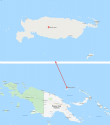
NS0309920 |
75k |

NS0404604 |
112k |
The Ship
|

NS0309904 |
96k |
USS Admiralty Islands (CVE-99), circa 1944. Camouflaged in Measure
32, Design 16A (thanks to Aryeh Wetherhorn.) |
Marvin Waid, son of Delbert Jay Waid. |

NS0309915 |
33k |
USS Admiralty Islands (CVE-99), starboard broadside view. |
Courtesy of PriorService.com, via Jack Treutle. |
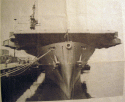
NS0309905 |
72k |
Bow view, circa 1945. |
Marvin Waid, son of Delbert Jay Waid. |
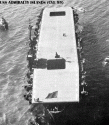
NS0309902 |
85k |
Date and place unknown.
Keith Anderson comments: "Th[is] photo of the Admiralty Islands [...] was taken before
the ship went to sea. Navigator Pete Cowan told me the dark shape on the foredeck were the deck stanchions
before they were installed." |
Haze Gray & Underway. |

NS0309911 |
116k |
USS Admiralty Islands (CVE-99), date and place unknown. |
Courtesy of Scott Koen & ussnewyork.com. |

NS0309921 |
189k |
USS Admiralty Islands (CVE-99) at San Diego, California,
23 October 1944, wearing camouflage scheme Measure 32, Design 16A.
National Archives and Records Administration (NARA) photo
# 19-LCM-CVE-99-1. |
Courtesy of C. Lee Johnson, usndazzle.com, via Mike
Green |

NS0309917 |
89k |
USS Admiralty Islands (CVE-99) underway on 31 December 1944,
ferrying planes and personnel from Pearl Harbor Navy Base. Note the PBY Catalina on the aft
flight deck. U.S. Navy photo. |
Mike Green. |
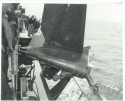
NS0309912 |
102k |
"This photo was taken onboard the USS Admiralty Islands (CVE-99)
on April 18th, 1945. The Escort Carrier was supporting the campaign to capture the island of Okinawa.
The photo shows the Grumman Hellcat Ensign Roy Edward Jones was flying,
seconds after his fatal crash on the USS Admiralty Islands. Ensign Jones was applying
full throttle after a wave-off, and the tail hook tragically caught the last wire slamming the aircraft
onto the deck. The Hellcat broke in half and the engine and cockpit went over the side. One
of Roy's fellow pilots—still in full flight gear—is shown looking over the side as the
aircraft sinks. The Hellcat is F6F-5 #71332. The aircraft was from the USS Essex
[(CV-9)]—a small bit of the distinctive USS Essex marking is visible on the tail."
"Charles E. Hubenthal wrote to me that he flew this very same Hellcat when he and Jack Lyons
sighted the Battleship Yamato on April 7th, 1945. The Yamato was sunk later that day.
Charles again flew this Hellcat on April 11th on a 5.0 hour CAP. The Essex was supporting
the Marine invasion of Okinawa at this time, and the planes were seeing very hard use."
"Roy was transporting the Hellcat to the USS Admiralty Islands for overhaul
or disposal. The men called these aircraft 'Flyable duds.'" |
Keith Anderson, grand nephew of ENS Roy Edward Jones. |
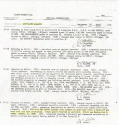
NS0309912a |
101k |
Copy of the deck log for the day of the accident, Wednesday, 18 April 1945. |

NS0309909a |
97k |
The second major accident, 20 July 1945. An aircraft attempting
to land released a fuel tank and set the deck (and three planes) on fire. The official record says
one man was killed, but eye witnesses say there were more. (See also NS0309908.)
Eyewitnesses recall:
"The other accident you inquired about involved planes that were not 'duds.' They were returning
from a strike on the Jap Home Islands. They were based on one of the large carriers, but it had a
crash landing with ensuing fire. The carrier asked us to take aboard their remaining air borne planes.
One of the pilots could not jettison his spare belly mounted gas tanks (required before landing).
We landed the other planes while he continued to try to jettison his tanks. With planes parked beyond
the forward wire barriers, we brought him aboard. When he caught the first arresting gear wire the
belly tank released, went flying down the flight deck, hit a flight deck crewman,exploded, throwing
gas on all the parked planes. It creamated the crewman and set ablaze all the parked planes and the
flight deck. I was on my way to the bridge at the time of the crash and was trapped in a small passageway
with burning gasoline at either end. Miraculously, I escaped without injury. As a result of the fire
damage we were ordered to the States for repairs to the Flight deck and arrived at San Pedro on V.J.
Day."
"I was not on the bridge at the time of touch down. I was en route to the bridge to get my evening
twilight sights. I usually went to the bridge about 45 minutes or so before twilight. When the crash
occurred I was in a small passage way between the combat intelligence center and the island. Burning
gasoline was spilling from the flight deck to each end of the passage way. My only way out was through
the door into the combat intelligence center which was a double door with a light lock. The light
lock was broken, so the outside door was locked so light would not show from the ship after dark.
With no other other way of escape, I pounded on the steel door in the hopes that someone would hear
me and open the door. No one heard me, but for some reason unknown to me, someone opened the door.
I ran through the CIC, down a ladder to the hanger deck, then aft to another ladder that would take
me to the flight deck. I took this path because the bridge got so hot it had to be abandoned because
of the fire. The captain announced on the P.A. system that the bridge was being abandoned and that
after steering station and steering engine room should be manned immediately. My battle station was
the after steering station which was designated 'Battle 2.' By the time I escaped the fiery passage
and reached the steering station (which was no more than a sponson just a few feet lower than the flight
deck and equipped with only a compass, and sound powered telephones for communication with main engine
and steering rooms), my quartermaster 2nd class had already 'taken command' stopped the engines so
no wind was crossing the deck to fan the fire and had a destroyer alongside with a fire hose wetting
down the flight deck."
"So much happened in such a short time. For several days people were trying to exchange information
and piece the whole thing together. I am almost certain the pilot who landed with the belly tank was
not injured. If a pilot was injured it had to be the pilot who had just landed, jumped from his plane
and ran. I seem to remember someone said he jumped from the flight deck to the forecastle. This is
quite a drop and could have caused a serious injury. It was still good light at the time, so I doubt
that darkness contributed to the accident. You had a good observation—why a belly tank for a
short flyable dud flight? My recollection is that these planes were diverted to our ship because of
an inoperative flight deck on their own ship." |
Keith Anderson, grand nephew of ENS Roy Edward Jones. |

NS0309909b |
273k |

NS0309909c |
259k |

NS0309909d |
276k |

NS0309909e |
295k |
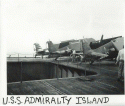
NS0309909 |
126k |
The aftermath of the second major accident aboard
USS Admiralty Islands (CVE-99). |

NS0309918 |
189k |
"This is a photo of the Admiralty Islands returning to California
shortly after the war. The large aircraft on the deck is a Catalina PBY. The Navigator Pete
Cowan told me they had to shift the ship's ballast to list the ship over enough to lift the PBY with
a crane onto the deck. I asked Pete how they got it off the carrier, and he said he had no idea—he
was too anxious to go on leave to care. Pete had enough points to leave the ship, but signed on for
a promotion and the Admiralty Islands was used for a period of time after the war to
transport soldiers and war materials back to the US." |
Keith Anderson, grand nephew of ENS Roy Edward Jones. |

NS0309919 |
49k |
USS Admiralty Islands (CVE-99) arrives in San Francisco, 25
November 1945, after a "Magic Carpet" run. Note how weathered her paint looks. |
Gerd Matthes, Germany. |
The Crew
|

NS0309906 |
106k |
Ship in background, with entire crew in front, Captain E. Eldredge, Commanding.
Taken by Thompson Photo, Los Angeles. |
Marvin Waid, son of Delbert Jay Waid. |

NS0309907 |
285k |
Sailors on deck. |
Marvin Waid, son of Delbert Jay Waid. |

NS0309901 |
20k |
Ensign Roy Edward Jones, USNR, became USS Admiralty Islands'
first operational casualty. On April 18, 1945, his plane was lost over the side while attempting
to land on her deck. Neither the pilot nor the plane was recovered. |
Keith Anderson, grand nephew of ENS Roy Edward Jones. |
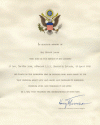
NS0309901a |
52k |
In grateful memory of
Roy Edward Jones
Who died in the service of his country
At Sea, Pacific Area, attached U.S.S. Admiralty Islands, 18 April 1945
He stands in the unbroken line of patriots who have dared to die
That freedom might live, and grow, and increase its blessings.
Freedom lives, and through it he lives—
In a way that humbles the understandings of most men.
/s/ Harry Truman
President of the United States of America |

NS0309914 |
49k |
This is a photo taken aboard USS Admiralty Islands. The man
standing, second from the left, is Pete Cowan, the navigator aboard the ship. |
Keith Anderson, grand nephew of ENS Roy Edward Jones. |
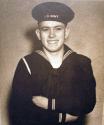
NS0309908 |
104k |
Delbert Jay Waid.
USS Admiralty Islands remained at Saipan "for approximately two weeks before she
received orders to join TG 30.8 and support air and bombardment strikes on the Japanese home islands.
Admiralty Islands sustained another operational casualty on 20 July [1945], when a plane
crashed while attempting to land. One man died as a result of the ensuing fire." (DANFS, Dictionary
of American Fighting Ships; see also NS0309909.)
When General Quarters was sounded after this crash, Delbert J.Waid steered the ship. |
Marvin Waid, son of Delbert Jay Waid. |

NS0309910 |
18k |
Images from the collection of Arthur Daniel Berkowitz, Electricians
Mate. After the war Arthur changed his last name to Berkley. |
Milton R. Berkley for his father, Arthur D. Berkley (Berkowitz). |

NS0309910a |
17k |

NS0309910b |
18k |

NS0309910c |
17k |

NS0309910d |
17k |

NS0309910e |
10k |

NS0309910f |
16k |
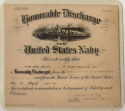
NS0309910g |
73k |
Memorabilia
|

NS0309913a |
507k |
Island Items, Vol.1, No.2, Maiden Voyage Issue (September 1944). |
Keith Anderson, grand nephew of ENS Roy Edward Jones. |

NS0309913 |
1.43M |
Island Items, 1st Birthday Issue (13 June 1945). |
Keith Anderson, grand nephew of ENS Roy Edward Jones. |

NS0309913b |
896k |
Island Items, Christmas '45, last ship's newspaper. |
Keith Anderson, grand nephew of ENS Roy Edward Jones. |

NS0309916 |
133k |
On the right and standing is Bratton Watson (Jeffrey's father); seated
is Frank ("Bull") Ernie Flowers; the gunners mate on the left is unknown, best guess is Marshall, Harry
Charles GM2/c. Bratton ended up in ship stores as an SK3/c. |
Jeffrey Watson, son of Bratton Watson. |
For more information about this ship, see:
|








































